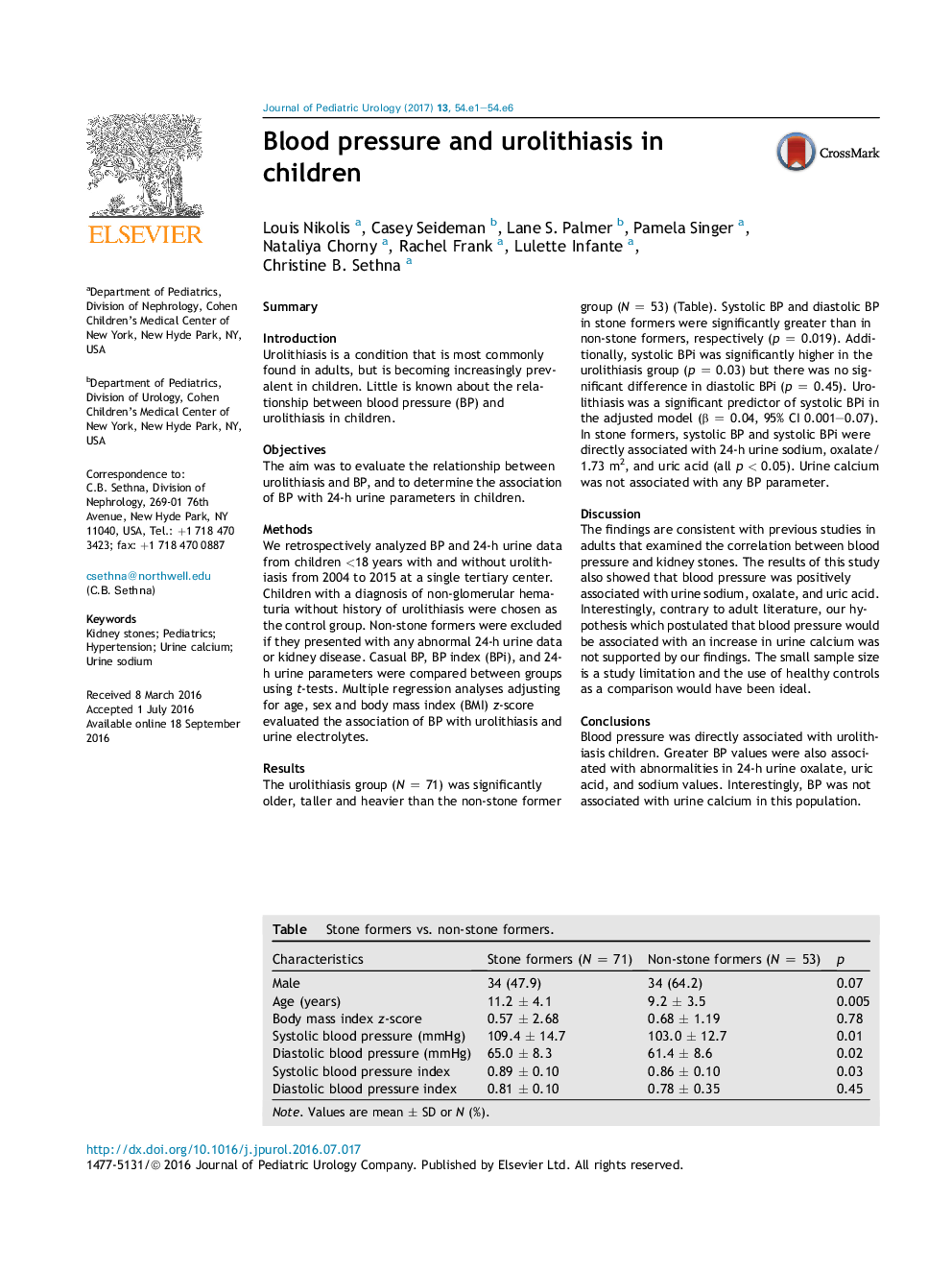| کد مقاله | کد نشریه | سال انتشار | مقاله انگلیسی | نسخه تمام متن |
|---|---|---|---|---|
| 5718658 | 1411255 | 2017 | 6 صفحه PDF | دانلود رایگان |
SummaryIntroductionUrolithiasis is a condition that is most commonly found in adults, but is becoming increasingly prevalent in children. Little is known about the relationship between blood pressure (BP) and urolithiasis in children.ObjectivesThe aim was to evaluate the relationship between urolithiasis and BP, and to determine the association of BP with 24-h urine parameters in children.MethodsWe retrospectively analyzed BP and 24-h urine data from children <18 years with and without urolithiasis from 2004 to 2015 at a single tertiary center. Children with a diagnosis of non-glomerular hematuria without history of urolithiasis were chosen as the control group. Non-stone formers were excluded if they presented with any abnormal 24-h urine data or kidney disease. Casual BP, BP index (BPi), and 24-h urine parameters were compared between groups using t-tests. Multiple regression analyses adjusting for age, sex and body mass index (BMI) z-score evaluated the association of BP with urolithiasis and urine electrolytes.ResultsThe urolithiasis group (N = 71) was significantly older, taller and heavier than the non-stone former group (N = 53) (Table). Systolic BP and diastolic BP in stone formers were significantly greater than in non-stone formers, respectively (p = 0.019). Additionally, systolic BPi was significantly higher in the urolithiasis group (p = 0.03) but there was no significant difference in diastolic BPi (p = 0.45). Urolithiasis was a significant predictor of systolic BPi in the adjusted model (β = 0.04, 95% CI 0.001-0.07). In stone formers, systolic BP and systolic BPi were directly associated with 24-h urine sodium, oxalate/1.73 m2, and uric acid (all p < 0.05). Urine calcium was not associated with any BP parameter.DiscussionThe findings are consistent with previous studies in adults that examined the correlation between blood pressure and kidney stones. The results of this study also showed that blood pressure was positively associated with urine sodium, oxalate, and uric acid. Interestingly, contrary to adult literature, our hypothesis which postulated that blood pressure would be associated with an increase in urine calcium was not supported by our findings. The small sample size is a study limitation and the use of healthy controls as a comparison would have been ideal.ConclusionsBlood pressure was directly associated with urolithiasis children. Greater BP values were also associated with abnormalities in 24-h urine oxalate, uric acid, and sodium values. Interestingly, BP was not associated with urine calcium in this population.Table. Stone formers vs. non-stone formers.CharacteristicsStone formers (N = 71)Non-stone formers (N = 53)pMale34 (47.9)34 (64.2)0.07Age (years)11.2 ± 4.19.2 ± 3.50.005Body mass index z-score0.57 ± 2.680.68 ± 1.190.78Systolic blood pressure (mmHg)109.4 ± 14.7103.0 ± 12.70.01Diastolic blood pressure (mmHg)65.0 ± 8.361.4 ± 8.60.02Systolic blood pressure index0.89 ± 0.100.86 ± 0.100.03Diastolic blood pressure index0.81 ± 0.100.78 ± 0.350.45Note. Values are mean ± SD or N (%).
Journal: Journal of Pediatric Urology - Volume 13, Issue 1, February 2017, Pages 54.e1-54.e6
